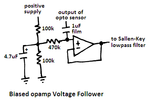Audioguru
Advanced Member level 7

- Joined
- Jan 19, 2008
- Messages
- 9,461
- Helped
- 2,152
- Reputation
- 4,304
- Reaction score
- 2,012
- Trophy points
- 1,393
- Location
- Toronto area of Canada
- Activity points
- 59,764
Yes.the pulse signal is AC from which the heartbeat rate is extracted.
So, if the Sallen-Key filter is used then a bias voltage should be applied, lets say for example if the supply voltage is 3V then the bias voltage needed is 1.5V Isn't it.
With a single-polarity +3V supply, the bias voltage is +1.5V then the output can swing almost +1.5V up to almost +3V and the output can swing almost 1.5V down to almost ground.How will it differ with the single and dual polarity supplies.
With a positive 1.5V and negative 1.5V dual-polarity supply, the bias voltage is 0V then the output can swing almost +1.5V and swing almost -1.5V.



